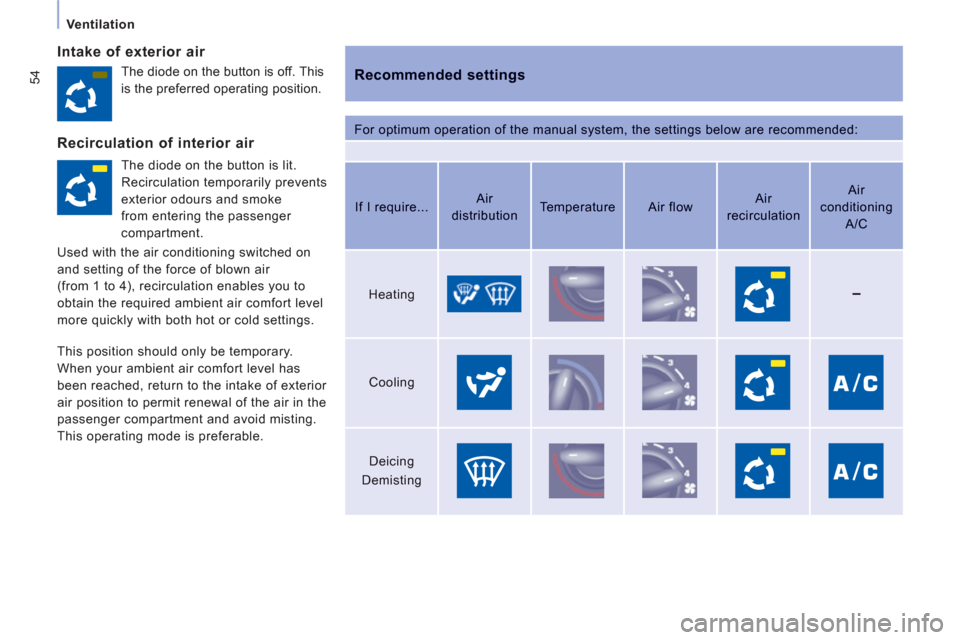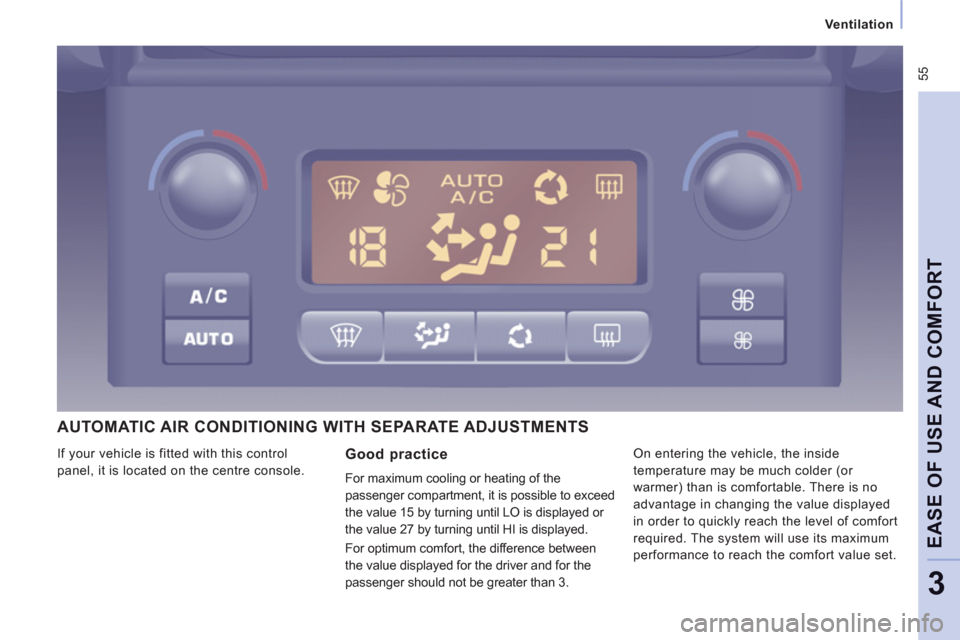2011 Peugeot Expert VU air condition
[x] Cancel search: air conditionPage 4 of 260

2
Contents
Remote control 19Key 20Alarm 21Doors 23Instrument panel 26Adjusting the time 27Warning lamps 28Fuel gauge 34Coolant 34Service indicator 35Lighting rheostat 36Gearboxes 37Gear shift indicator 37Automatic gearbox 38Steering wheel adjustment 41Starting and stopping 41
Lighting 42controls 42wipers 45Cruise control 47Fixed speed limiter 49Speed limiter 50Manual heating/air conditioning53automatic 55De-icing and demisting 59Additional heating 61Seats 642-seat front bench 66Cab fittings 68Courtesy lights 71Toll cards/car park tickets 71Crew cab 72Load space fittings 73Rear suspension 76Mirrors 79Electric windows 81
2. READY TO
SET OFF 19-414. SAFETY 82-97
Presentation 4Communication4Exterior 5Sitting comfortably 10Seeing clearly 12Driving safely 13Cab layout 14Load space 15Ventilation 16Eco-driving 17
1. FAMILIARISATION 4-18
Parking brake 82Hazard warning lamps 82Parking sensors 83Horn 84Anti-lock braking system (ABS) 84Emergency braking assistance 84Traction control (ASR) andstability control (ESP) 85Seat belts 86Airbags 89Lateral airbags 91Front airbags 92Deactivating the passenger'sairbag 92Child seats 93Recommended seats 95
3. EASE OF USE and COMFORT 42-81
Page 11 of 260

9
Interior
FAMILIARISATIO
N
1
CENTRE CONSOLE AND OVERHEAD STORAGE UNIT
1.
Location of controls:
- central locking/unlocking,
- locking/unlocking the load space.
2.
Heating and/or air conditioning
controls.
3.
Location of the ticket/card storage or
controls:
- deactivation the ESP,
- deactivation of the interior
protection alarm, alarm LED,
- deactivation of the parking
sensors.
4.
Storage compartment.
5.
Audio system or storage
compartment.
6.
Central adjustable vents.
7.
Hazard warning lamps switch.
8.
Screen or storage compartment.
9.
Courtesy lamp.
10.
Passenger's airbag deactivated
warning lamp
11 .
Location of the ticket/card storage,
heated seat controls.
ADJUSTING THE TIME
- a centre console with screen: refer to
"Adjusting the date and time" in section 9,
- a centre console without screen: refer to
"Instruments and controls" in section 2.
Depending on the configuration of your
vehicle, you have either:
Page 19 of 260

17
FAMILIARISATIO
N
1
ECO-DRIVING
Eco-driving is a range of everyday practices that allow the motorist to optimise their fuel
consumption and CO
2 emissions.
Optimise the use of your
gearbox
With a manual gearbox, move off gently,
change up without waiting and drive by
changing up quite soon. If your vehicle has
the system, the gear shift indicator invites
you to change up; it is displayed in the
instrument panel, follow its instructions.
With an automatic or electronic gearbox,
stay in Drive "D"
or Auto "A"
, according to
the type of gearbox, without pressing the
accelerator pedal heavily or suddenly.
Control the use of your
electrical equipment
Before moving off, if the passenger
compartment is too warm, ventilate it by
opening the windows and air vents before
using the air conditioning.
Above 30 mph (50 km/h), close the
windows and leave the air vents open.
Switch off the headlamps and front
foglamps when the level of light does not
require their use.
Avoid running the engine before moving
off, particularly in winter; your vehicle will
warm up much faster while driving.
Drive smoothly
Maintain a safe distance between
vehicles, use engine braking rather than
the brake pedal, and press the accelerator
progressively. These practices contribute
towards a reduction in fuel consumption
and CO
2 emissions and also helps reduce
the background traffic noise.
If your vehicle has cruise control, make
use of the system at speeds above 25 mph
(40 km/h) when the traffi c is fl owing well.
As a passenger, if you avoid connecting
your multimedia devices (film, music,
video game...), you will contribute towards
limiting the consumption of electrical
energy, and so of fuel.
Disconnect your portable devices before
leaving the vehicle.
Remember to make use of equipment
that can help keep the temperature in the
passenger compartment down (sun roof
and window blinds...).
Switch off the air conditioning, unless it
has automatic digital regulation, as soon
as the desired temperature is attained.
Switch off the demisting and defrosting
controls, if not automatic.
Switch off the heated seat as soon as
possible.
Page 45 of 260

43
Steering mounted controls
EASE OF USE AND COMFOR
T
3
Front fog lights (green)
and rear fo
g lights (amber,
2nd rotation o
f the ring
forwards).
To switch o
ff the front and rear fog
lights, turn the ring rearwards twice in
succession.
In clear weather or in rain, both day
and night, rear fog lights dazzle and
are prohibited.
Do not for
get to switch them off when they
are no longer needed.
Automatic switchin
g on of the lights switches
o
ff the rear fog lamps, but the front fog
lamps remain on.
Daytime lights
Depending on the country in which the
vehicle is sold, the vehicle ma
y be equipped
w
ith daytime lights. The dipped headlamps
come on when the vehicle is started.
Th
e instruments and controls
(instrument panel, display, air
conditioning control panel, ...) are only lit
on switchin
g to the automatic switching on
of the li
ghts mode or when the lights are
switched on manually.
Front and rear fog lights
Rotate ring Bforwards to switch on and
rearwards to switch off. The status is
confirmed by the light on the instrument
panel.
These operate with the side lights and the
di
pped beam headlamps.
Front
fog lights (green, 1st
rotation of the ring forwards).
This warning light comes on on
the instrument panel.
Page 55 of 260

Ventilation
EASE OF USE AND COMFOR
T
3
WITH MANUAL ADJUSTMENT
If your vehicle is fitted with these controls,
the
y are located on the control panel of the
fascia centre console.
Air distribution
The air supply distribution is directed by the
control turned towards:
t
he side vents and the central
vents,
t
he side vents, the central vents
and the
footwells,
the footwells,
the windscreen and the
footwells,
Air flow
The air conditioning does not operate if the
air flow is set to 0.
th
e windscreen.
Air conditioning A/C
If fitted on your vehicle, the air conditioning
can only operate with the engine running.
Pressing the button triggers the
operation of the air conditioning,
the diode is lit. Pressin
g the
button a
gain switches the function
off and the diode is switched off.
Temperature adjustment
Control positioned:
-
in the red zone, triggers heating
of the interior ambient air.
- in the blue zone, triggers cool air,
The air distribution can be
modulated by placing the control
in the intermediate positions,
m
arked "●". The
force of the blown air, from
the vents, varies
from 1 to the
strongest 4. Position 0 switches it off.
Remember to ad
just this control
in order to reach the ambient air
comfort level.
VENTILATION
Page 56 of 260

54
Ventilation
Intake of exterior air
Recommended settings
For optimum operation of the manual system, the settings below are recommended: Th
e diode on the button is off. This
is the pre
ferred operating position.
Recirculation of interior air
The diode on the button is lit.
Recirculation temporarily prevents
exterior odours and smoke
from entering the passenger
compartment.
Used with the air conditionin
g switched on
and settin
g of the force of blown air
(from 1 to 4), recirculation enables you to
obtain the re
quired ambient air comfort level
more quickly with both hot or cold settings.
This position should onl
y be temporary.
When your ambient air comfort level has
been reached, return to the intake o
f exterior
air position to permit renewal of the air in the
passenger compartment and avoid misting.
This operatin
g mode is preferable.
If I require... Air
distribution
Te mperature
Air flow Air
recirculation
Air
conditioning
A/C
Heating
Cooling
Deicing
Demisting
Page 57 of 260

55
Ventilation
EASE OF USE AND COMFOR
T
3
AUTOMATIC AIR CONDITIONING WITH SEPARATE ADJUSTMENTS
Good practice
For maximum cooling or heating of the
passen
ger compartment, it is possible to exceed
the value 15 b
y turning until LO is displayed or
the value 27 b
y turning until HI is displayed.
For optimum com
fort, the difference between
the value displa
yed for the driver and for the
passen
ger should not be greater than 3. I
f your vehicle is fitted with this control
panel, it is located on the centre console.
On entering the vehicle, the inside
temperature ma
y be much colder (or
warmer
) than is comfortable. There is no
a
dvantage in changing the value displayed
in order to quickl
y reach the level of comfort
required. The system will use its maximum
performance to reach the comfort value set.
Page 58 of 260

56
Ventilation
Driver or passenger side comfort value
The value indicated on the display
corresponds to a level of comfort and
not a temperature in de
grees Celsius or
F
ahrenheit.
Automatic operation
Do not cover the sunshine sensor,
l
ocated on the windscreen behind the
mirror, it is used for regulation of the air
conditioning.
AUTO comfort programme
This is the normal air conditioning system
operat
ing mode.
Press this button, the AUTO
symbol is
displayed.
In
accordance with the comfort valueselected, the system controls the
distribution, the fl ow and the intake of air to guaranteecomfort and a suffi cient circulation of air in the
passenger compartment. No further action on your part
is required. No further action on your part is required.
When the engine is cold, to prevent anexcessive diffusion of cold air, the ventilation
will reach its optimum level gradually.
For
your comfort, the settings are stored
when the ignition is switched off and arereinstated the next time the vehicle isstarted, if the temperature in the passenger compartment has not changed significantly;
otherwise, operation resumes in automatic
mode. T
urn this control to the left or to
the right to decrease or increase
the value. A settin
g around the
value 21 provides optimum
comfort. However, depending on your
requirements, a settin
g between 18 and 24
i
s usual.